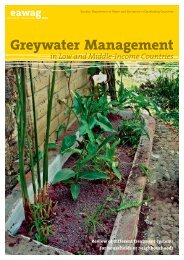Household Water Treatment and Safe Storage Factsheet: Source ...
Household Water Treatment and Safe Storage Factsheet: Source ...
Household Water Treatment and Safe Storage Factsheet: Source ...
You also want an ePaper? Increase the reach of your titles
YUMPU automatically turns print PDFs into web optimized ePapers that Google loves.
<strong>Household</strong> <strong>Water</strong> <strong>Treatment</strong> <strong>and</strong> <strong>Safe</strong> <strong>Storage</strong><br />
Fact Sheet: Straining<br />
The <strong>Treatment</strong> Process<br />
Potential <strong>Treatment</strong> Capacity<br />
Very Effective For: Somewhat Effective For: Not Effective For:<br />
Helminths<br />
Protozoa<br />
Turbidity<br />
Bacteria<br />
Taste, odour, colour<br />
Viruses<br />
Chemicals<br />
What is Straining?<br />
Straining water through a cloth has been<br />
widely used for household water treatment<br />
in many cultures for centuries. A common<br />
sari cloth is usually used for this in South<br />
Asia, for example.<br />
How Does it Remove Contamination?<br />
The pore size range in old (laundered) sari<br />
cloth is 100–150 μm, but about 20 μm if the<br />
cloth is folded four to eight times. The holes<br />
allow water to pass but retain particles <strong>and</strong><br />
pathogens >20 μm.<br />
Straining through sari cloth has been shown<br />
to be effective in filtering out the plankton to<br />
which cholera bacteria may attach<br />
themselves, therefore reducing the risk of<br />
cholera. This simple method can also filter<br />
out many helminths <strong>and</strong> their eggs <strong>and</strong><br />
larvae.<br />
Old sari cloth made of cotton was found to<br />
be most effective in removing cholera based<br />
on laboratory experiments (Colwell et al.,<br />
2002). After several launderings, threads of<br />
an old sari become soft <strong>and</strong> loose, reducing<br />
the pore size, compared with new sari cloth.<br />
Electron micrographs of a single layer of sari cloth<br />
filters (Credit: Colwell et al., 2002)<br />
Operation<br />
Fold a large, clean piece of cloth seven to<br />
eight times. Place the folded cloth over a<br />
clean water container, <strong>and</strong> secure in place.<br />
Pour water through the cloth into the<br />
container. Wash the cloth in clean water<br />
before using it again.<br />
A woman uses a sari cloth to strain water
















